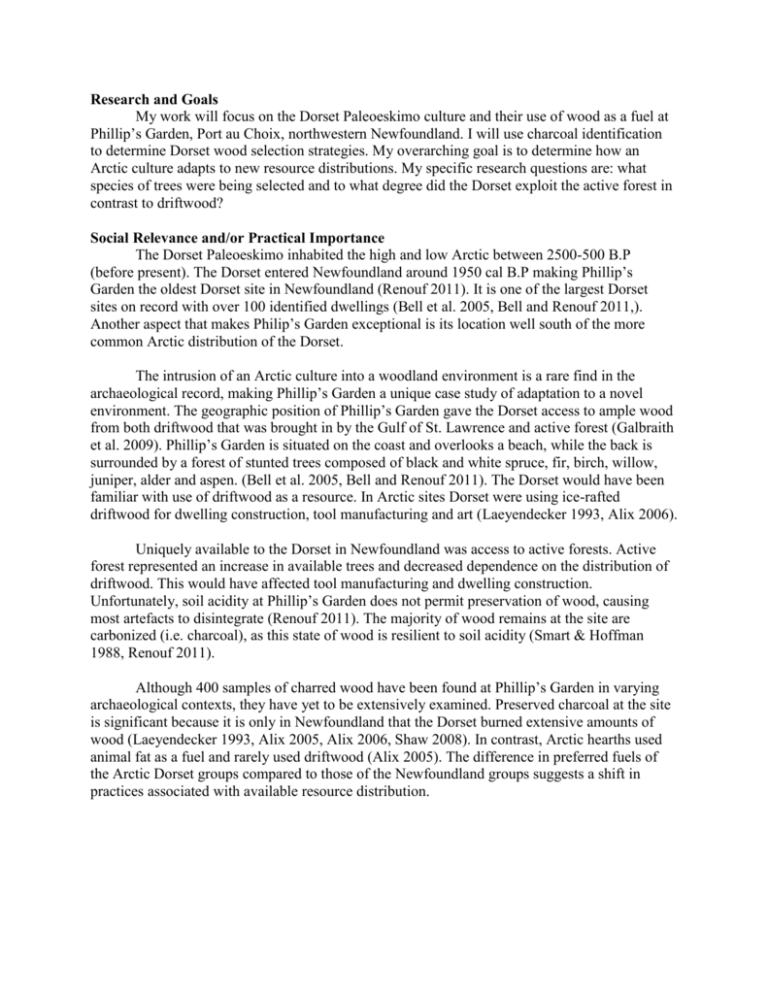"wood" the Dorset do?
advertisement

Research and Goals My work will focus on the Dorset Paleoeskimo culture and their use of wood as a fuel at Phillip’s Garden, Port au Choix, northwestern Newfoundland. I will use charcoal identification to determine Dorset wood selection strategies. My overarching goal is to determine how an Arctic culture adapts to new resource distributions. My specific research questions are: what species of trees were being selected and to what degree did the Dorset exploit the active forest in contrast to driftwood? Social Relevance and/or Practical Importance The Dorset Paleoeskimo inhabited the high and low Arctic between 2500-500 B.P (before present). The Dorset entered Newfoundland around 1950 cal B.P making Phillip’s Garden the oldest Dorset site in Newfoundland (Renouf 2011). It is one of the largest Dorset sites on record with over 100 identified dwellings (Bell et al. 2005, Bell and Renouf 2011,). Another aspect that makes Philip’s Garden exceptional is its location well south of the more common Arctic distribution of the Dorset. The intrusion of an Arctic culture into a woodland environment is a rare find in the archaeological record, making Phillip’s Garden a unique case study of adaptation to a novel environment. The geographic position of Phillip’s Garden gave the Dorset access to ample wood from both driftwood that was brought in by the Gulf of St. Lawrence and active forest (Galbraith et al. 2009). Phillip’s Garden is situated on the coast and overlooks a beach, while the back is surrounded by a forest of stunted trees composed of black and white spruce, fir, birch, willow, juniper, alder and aspen. (Bell et al. 2005, Bell and Renouf 2011). The Dorset would have been familiar with use of driftwood as a resource. In Arctic sites Dorset were using ice-rafted driftwood for dwelling construction, tool manufacturing and art (Laeyendecker 1993, Alix 2006). Uniquely available to the Dorset in Newfoundland was access to active forests. Active forest represented an increase in available trees and decreased dependence on the distribution of driftwood. This would have affected tool manufacturing and dwelling construction. Unfortunately, soil acidity at Phillip’s Garden does not permit preservation of wood, causing most artefacts to disintegrate (Renouf 2011). The majority of wood remains at the site are carbonized (i.e. charcoal), as this state of wood is resilient to soil acidity (Smart & Hoffman 1988, Renouf 2011). Although 400 samples of charred wood have been found at Phillip’s Garden in varying archaeological contexts, they have yet to be extensively examined. Preserved charcoal at the site is significant because it is only in Newfoundland that the Dorset burned extensive amounts of wood (Laeyendecker 1993, Alix 2005, Alix 2006, Shaw 2008). In contrast, Arctic hearths used animal fat as a fuel and rarely used driftwood (Alix 2005). The difference in preferred fuels of the Arctic Dorset groups compared to those of the Newfoundland groups suggests a shift in practices associated with available resource distribution.






